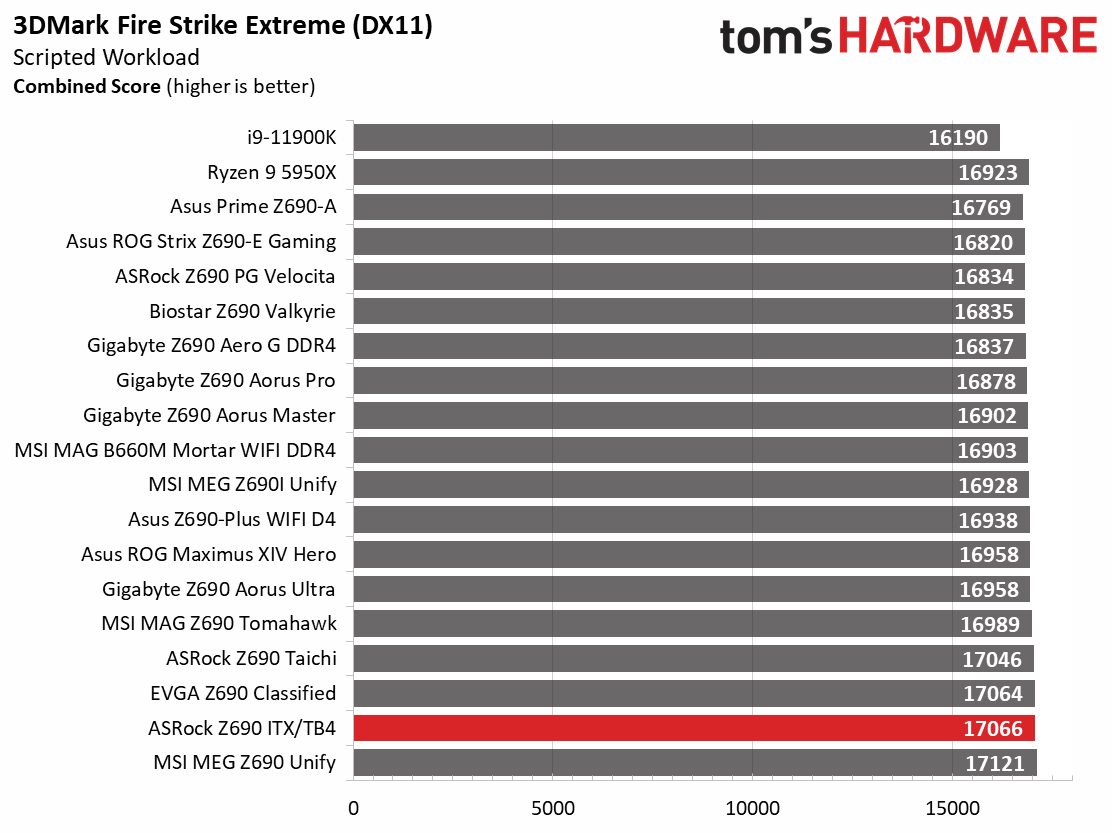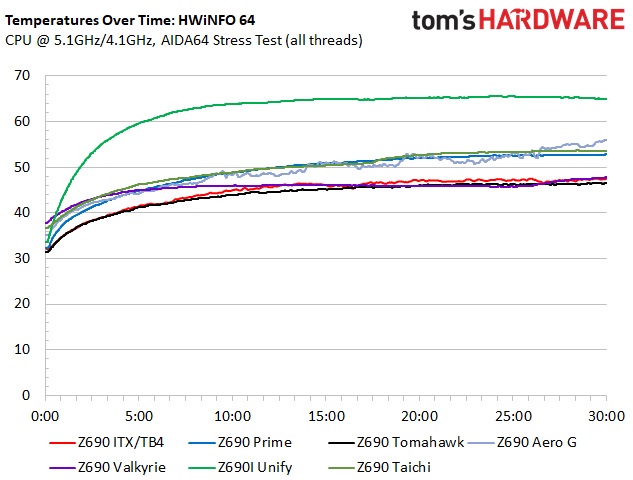Why you can trust Tom's Hardware
Our standard benchmarks and power tests are performed using the CPU’s stock frequencies (including any default boost/turbo), with all power-saving features enabled. We set optimized defaults in the BIOS and the memory by enabling the XMP profile. For this baseline testing, the Windows power scheme is set to balanced (default), so the PC idles appropriately.
To get the most out of the Intel Alder Lake chips, you need to be on Windows 11 with its updated scheduler. In most cases, Windows 10 performs well. However, some tests (Cinebench R20, Corona and POVRay) take a significant hit. In short, if you’re going with Alder Lake, you must upgrade to Windows 11 for the best results across the board. That may change with patching and updates in the future, though.
Synthetic Benchmarks
Synthetics provide a great way to determine how a board runs, as identical settings should produce similar performance results. Turbo boost wattage and advanced memory timings are places where motherboard makers can still optimize for either stability or performance, though, and those settings can impact some testing.

















The Z690 ITX-TB4 was hit or miss in this set of tests. Some tests, like 7-Zip, Cinebench and AIDA64 memory testing, were slower than average, while the Procyon Office tests were some of the faster results we’ve seen recently. That said, nothing was especially slow, so there are no worries here.
Timed Applications




In these tests, Z690 ITX/TB4 was spot on average. Handbrake, LAME, and Corona benchmarks show again that there’s nothing to be concerned about.
3D Games and 3DMark




Starting with the launch of the Z690 chipset, we’ve updated our game tests. We’ve updated Far Cry: New Dawn to Far Cry 6 and shifted from F1 2020 to F1 2021. We run the games at 1920x1080 resolution using the Ultra preset (details listed above). As the resolution goes up, the CPU tends to have less impact. The goal with these settings is to determine if there are differences in performance at the most commonly used resolution with settings most people use or at least strive for. We expect the difference between boards in these tests to be minor, with most falling within the margin of error differences. We’ve also added a minimum FPS value, as that can affect your gameplay and immersion experience.
In F1 2021, the ITX/TB4 reached an average of 162 frames per second (fps), with minimums of 142 fps, both on the higher end of results, with the minimum the fastest so far. Far Cry 6 testing resulted in average results. In that test, we averaged 138 fps, with a minimum of 125 fps.
Get Tom's Hardware's best news and in-depth reviews, straight to your inbox.
The synthetic benchmarks continue to show a negligible difference between the fastest and slowest boards. Our ASRock ITX board hit 14,474 on 3DMark Time Spy and 17,066 on Fire Strike Extreme, both on the higher side of average. In short, gaming performance is as expected.
Power Consumption / VRM Temperatures
We used AIDA64’s System Stability Test with Stress CPU, FPU and Cache enabled for power testing, using the peak power consumption value. The wattage reading is from the wall via a Kill-A-Watt meter to capture the entire PC minus the monitor. The only variable that changes is the motherboard; all other parts are the same.
At idle, the ITX/TB4 used 62W, which is around the average of our tested boards. Load wattage peaked at 318W, or just above average. Overall this little board does use a bit more power than some others we’ve tested. However, noticing this difference on your electric bill will be difficult.




VRM temperatures peaked around 46 degrees Celsius on our Extech device sensors, but over 66 degrees on the internal sensor at stock speeds. This is one of the largest differences between our sensors and on-board sensors. If we’re going by the internal sensor (which is what the system goes by), it ran warm but well within specifications. I would like to see these temperatures lower with active cooling, but they are still fine. The tiny fan was active but inaudible, which is how we like it.
Overclocking
Overclocking with Alder Lake is slightly different from what we’re used to due to the hybrid core configuration. Now, you can overclock the P and E cores separately, though they both use the same voltage domain. You can push one and not the other, or both, so there’s some flexibility. To that end, we set an overclock to 5.1 GHz across all P-cores and 4.1Ghz on all E-cores. This yields a 200 MHz bump on the P-cores and a 400 MHz increase on the E-cores. We’re topped out on the P-cores, primarily due to temperatures, but the more efficient E-cores still have some headroom.
Overclocking with Z690 ITX/TB4 and the flagship 8+8-core/24-thread i9-12900K proved painless. Since we’ve found our required voltage with our first review, we plugged in that 1.25V value for Vcore, adjusted LLC to LLC1, and tested it successfully. According to CPUz, the voltage was 1.23V, so using LLC1 effectively mitigated vdroop.
On the memory front, we set XMP for both kits (GSkill Trident Z5 DDR5 5600 CL36, ADATA XPG DDR5 6000 kit) without issue. This yields an 800 and 1,200 MHz (respectively) increase from the maximum stock rating of the platform (DDR5 4800). With more kits becoming available and prices dropping, we’d call this range a sweet spot between price and performance for DDR5.
Bottom Line
After spending some time with the ASRock Z690 Phantom Gaming-ITX/TB4 ($349.99), we found that it is just as capable as pricier options in some ways, but lacking in others. The PG-ITX/TB4 sports two M.2 sockets, integrated Thunderbolt 4, three SATA ports, Killer-based Networking, and robust 105A MOSFETs on the VRM. Although not much has changed on the board itself, pricing did jump from the last-gen PG-ITX/TB4 by over $50. While there are many redeeming qualities, I would still like to see this board cost less.
As far as shortcomings are concerned, the three SATA ports will be too few for some users, as will the five USB Type-A ports on the rear IO (six in total, including the Thunderbolt 4 Type-C port). The PG-ITX/TB4 also uses the last-gen flagship audio codec, but we can’t be too upset as most users will find this solution satisfactory.
Each board partner has its own Mini-ITX Z690 options. Asus has the ROG Strix Z690-I Gaming ($439.99), MSI the MEG Z690I Unify ($399.99), and Gigabyte has the Z690I Aorus Ultra ($309.99). If your needs are focused around storage, the Gigabyte with two M.2 sockets and two SATA ports is out, even at its notably lower price point, while the Z690I Unify has the most (three M.2 sockets and four SATA ports). The ASRock is the only board in this group with last-generation Realtek audio, but few would notice a difference. These boards include capable power delivery and would easily power any Alder Lake processor. Only the ASRock and MSI boards offer integrated Thunderbolt 4, so only those two fit the bill if that's a requirement. In the end, the difference comes down to hardware requirements (in particular rear IO USB count and storage capabilities), price, and looks, of which none of these boards made significant improvements.
Overall, the ASRock Z690 Phantom Gaming-ITX/TB4 is a good option in the Z690 Mini-ITX space. It looks as good as an ITX board can, is priced reasonably among its peers, and has the specifications and features to back it up. While we feel the MSI Z690I Unify is the most well-rounded solution in the bunch, If you’re looking to spend less, require Thunderbolt 4 connectivity, and can work with the rear IO and storage limitations, ASRock’s Z690 PG-ITX/TB4 fits the bill.
MORE: Best Motherboards
MORE: How To Choose A Motherboard
MORE: All Motherboard Content

Joe Shields is a staff writer at Tom’s Hardware. He reviews motherboards and PC components.
-
tennis2 $350...insaneReply
Can I suggest placing the "best" metric at the top of the charts. Whether that's "lower is better" or "higher is better". -
Co BIY ITX could have an appeal to me ... if it didn't always cost more.Reply
Even priced the same as mATX would make sense but priced higher it looses appeal for me.
Complaining about fewer SATA ports on an ITX board seems silly.
If one needed (max) for transfer of data only. -
tennis2 @ AsRock, please give us mITX boards with 4 SODIMM slots. If you use a fixed peg in the middle, 2 SODIMMs will fit in the same slot length as a desktop stickReply -
ocer9999 Asrock does solid ITX motherboards, this Z690 Phantom is a good example. The pricing is on the high side, but all Z690 are. I see B660 selling for close to 200$ which is pretty crazy, so this price for a good ITX Z690 is not out of this world.Reply

